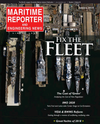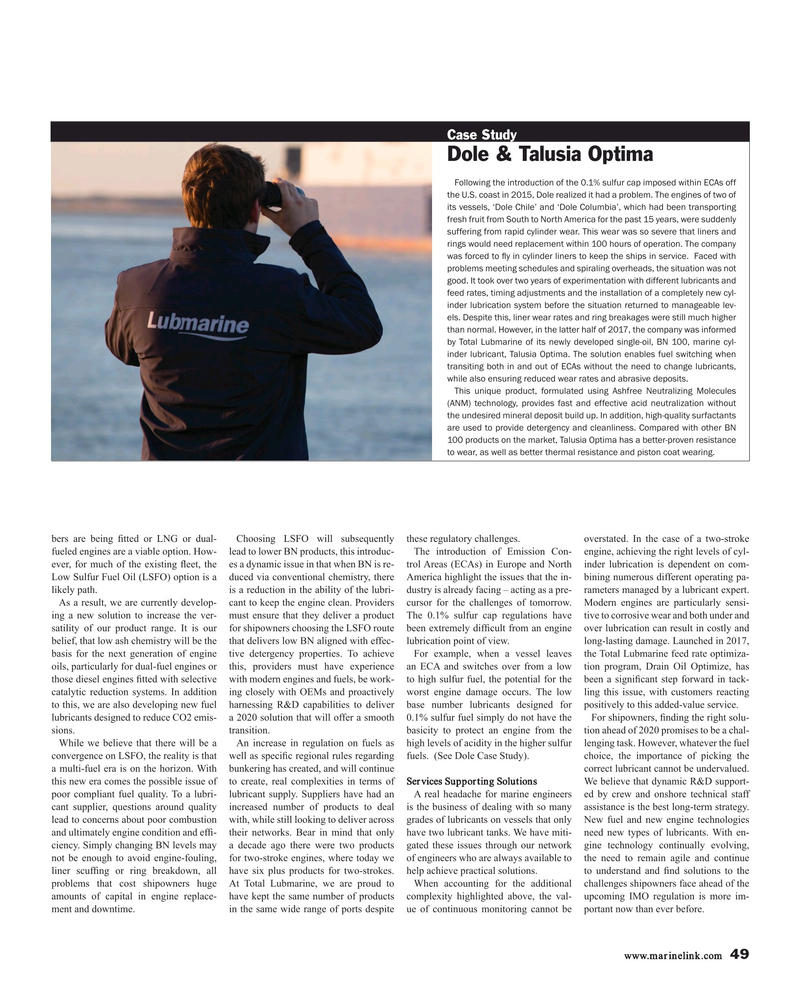
Page 49: of Maritime Reporter Magazine (January 2019)
Ship Repair & Conversion: The Shipyards
Read this page in Pdf, Flash or Html5 edition of January 2019 Maritime Reporter Magazine
Case Study
Dole & Talusia Optima
Following the introduction of the 0.1% sulfur cap imposed within ECAs off the U.S. coast in 2015, Dole realized it had a problem. The engines of two of its vessels, ‘Dole Chile’ and ‘Dole Columbia’, which had been transporting fresh fruit from South to North America for the past 15 years, were suddenly suffering from rapid cylinder wear. This wear was so severe that liners and rings would need replacement within 100 hours of operation. The company was forced to ? y in cylinder liners to keep the ships in service. Faced with problems meeting schedules and spiraling overheads, the situation was not good. It took over two years of experimentation with different lubricants and feed rates, timing adjustments and the installation of a completely new cyl- inder lubrication system before the situation returned to manageable lev- els. Despite this, liner wear rates and ring breakages were still much higher than normal. However, in the latter half of 2017, the company was informed by Total Lubmarine of its newly developed single-oil, BN 100, marine cyl- inder lubricant, Talusia Optima. The solution enables fuel switching when transiting both in and out of ECAs without the need to change lubricants, while also ensuring reduced wear rates and abrasive deposits.
This unique product, formulated using Ashfree Neutralizing Molecules (ANM) technology, provides fast and effective acid neutralization without the undesired mineral deposit build up. In addition, high-quality surfactants are used to provide detergency and cleanliness. Compared with other BN 100 products on the market, Talusia Optima has a better-proven resistance to wear, as well as better thermal resistance and piston coat wearing.
bers are being ? tted or LNG or dual- Choosing LSFO will subsequently these regulatory challenges. overstated. In the case of a two-stroke fueled engines are a viable option. How- lead to lower BN products, this introduc- The introduction of Emission Con- engine, achieving the right levels of cyl- ever, for much of the existing ? eet, the es a dynamic issue in that when BN is re- trol Areas (ECAs) in Europe and North inder lubrication is dependent on com-
Low Sulfur Fuel Oil (LSFO) option is a duced via conventional chemistry, there America highlight the issues that the in- bining numerous different operating pa- likely path. is a reduction in the ability of the lubri- dustry is already facing – acting as a pre- rameters managed by a lubricant expert.
As a result, we are currently develop- cant to keep the engine clean. Providers cursor for the challenges of tomorrow. Modern engines are particularly sensi- ing a new solution to increase the ver- must ensure that they deliver a product The 0.1% sulfur cap regulations have tive to corrosive wear and both under and satility of our product range. It is our for shipowners choosing the LSFO route been extremely dif? cult from an engine over lubrication can result in costly and belief, that low ash chemistry will be the that delivers low BN aligned with effec- lubrication point of view. long-lasting damage. Launched in 2017, basis for the next generation of engine tive detergency properties. To achieve For example, when a vessel leaves the Total Lubmarine feed rate optimiza- oils, particularly for dual-fuel engines or this, providers must have experience an ECA and switches over from a low tion program, Drain Oil Optimize, has those diesel engines ? tted with selective with modern engines and fuels, be work- to high sulfur fuel, the potential for the been a signi? cant step forward in tack- catalytic reduction systems. In addition ing closely with OEMs and proactively worst engine damage occurs. The low ling this issue, with customers reacting to this, we are also developing new fuel harnessing R&D capabilities to deliver base number lubricants designed for positively to this added-value service. lubricants designed to reduce CO2 emis- a 2020 solution that will offer a smooth 0.1% sulfur fuel simply do not have the For shipowners, ? nding the right solu- sions. transition. basicity to protect an engine from the tion ahead of 2020 promises to be a chal-
While we believe that there will be a An increase in regulation on fuels as high levels of acidity in the higher sulfur lenging task. However, whatever the fuel convergence on LSFO, the reality is that well as speci? c regional rules regarding fuels. (See Dole Case Study). choice, the importance of picking the a multi-fuel era is on the horizon. With bunkering has created, and will continue correct lubricant cannot be undervalued. this new era comes the possible issue of to create, real complexities in terms of Services Supporting Solutions We believe that dynamic R&D support- poor compliant fuel quality. To a lubri- lubricant supply. Suppliers have had an A real headache for marine engineers ed by crew and onshore technical staff cant supplier, questions around quality increased number of products to deal is the business of dealing with so many assistance is the best long-term strategy. lead to concerns about poor combustion with, while still looking to deliver across grades of lubricants on vessels that only New fuel and new engine technologies and ultimately engine condition and ef? - their networks. Bear in mind that only have two lubricant tanks. We have miti- need new types of lubricants. With en- ciency. Simply changing BN levels may a decade ago there were two products gated these issues through our network gine technology continually evolving, not be enough to avoid engine-fouling, for two-stroke engines, where today we of engineers who are always available to the need to remain agile and continue liner scuf? ng or ring breakdown, all have six plus products for two-strokes. help achieve practical solutions. to understand and ? nd solutions to the problems that cost shipowners huge At Total Lubmarine, we are proud to When accounting for the additional challenges shipowners face ahead of the amounts of capital in engine replace- have kept the same number of products complexity highlighted above, the val- upcoming IMO regulation is more im- ment and downtime. in the same wide range of ports despite ue of continuous monitoring cannot be portant now than ever before.
www.marinelink.com 49
MR #1 (42-49).indd 49 MR #1 (42-49).indd 49 1/14/2019 11:18:13 AM1/14/2019 11:18:13 AM

 48
48

 50
50
